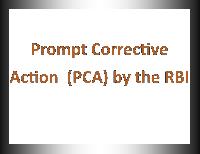
RBI’s Prompt Corrective Action (PCA) Framework is a set of guidelines for banks that are weak in terms of identified indicators including – poor asset quality, insufficient capital and insufficient profit or losses.
The PCA is an early intervention package or resolution guideline by the RBI when a bank turns weak in terms of the identified indicators.
The Reserve Bank of India initiated the Scheme of Prompt Corrective Action (PCA) in 2002 to discipline banks when they report poor and risky financial performance.
PCA is a policy action guideline (first in May 2014 and revised effective from April 1, 2017) if a commercial bank’s financial condition worsens below a mark.
In early 2018, there were 12 banks under PCA framework, implying that their financial conditions were weak. Out of these, 11 were PSBs. Later, the government injected capital into the PSBs besides making several steps to improve their performance. As a result, as on March 9, 2019, there were only six banks (all PSBs) under the PCA framework.
What is the criterial for identifying bank as PCA category bank?
The PCA framework specifies the trigger points or the level in which the RBI will intervene with corrective action. This trigger points are expressed in terms of parameters for the banks.
The trigger points are: capital to risk weighted assets ratio (CRAR), net non-performing assets (NNPA), and return on assets (RoA). This means that when a particular bank is reporting the low level of CRAR high level of NNPA or Return on Assets (profit), the RBI will ask it to adopt certain restrictive measures.
The scheme was revised in April 2017. Under the Revised PCA framework, apart from the capital, asset quality and profitability, leverage is to be monitored additionally.
The parameters that invite corrective action from the central bank are:
- Capital to Risk weighted Asset Ratio (CRAR)
- Net Non-Performing Assets (NPA) and
- Return on Assets (RoA)
- Leverage ratio
When these parameters reach the set trigger points for a bank (like CRAR of 9%, 6%, 3%), the RBI will initiate certain structured and discretionary actions for the bank. As per the revised framework by the RBI, in April 2017, capital, asset quality and profitability continue to be the key areas for monitoring. Along with this, leverage of banks also will be monitored.
What the banks under PCA should do?
When a bank is brought into the PCA framework, it should face restrictions on distributing dividends, remitting profits and even on accepting certain kinds of deposits. Besides, there are restrictions on the expansion of branch network, and the lenders need to maintain higher provisions, along with caps on management compensation and directors’ fees. The entire thrust of the PCA framework is to prevent further capital erosion and to bring back the bank to normal healthy conditions.
Some of the structured and discretionary actions that could be taken by the Reserve Bank are: recapitalization, restrictions on borrowing from inter-bank market to steps to merge/amalgamate/liquidate the bank or impose moratorium on the bank if its CRAR does not improve beyond etc.). The corrective actions are tough with worsening of the financials. Major trigger points in the original format were:
CRAR
(i) CRAR less than 9%, but equal or more than 6%
(ii) CRAR less than 6%, but equal or more than 3%
(iii) CRAR less than 3%
NPAs
(i) Net NPAs over 10% but less than 15%
(ii) Net NPAs 15% and above
ROA below 0.25%
The PCA framework is applicable only to commercial banks and not extended to co-operative banks, non-banking financial companies (NBFCs) and FMIs.
PCA Framework banks as on March 2019
As on March 9, 2019, there are only six banks which are under the PCA Framework. All these banks are PSBs: Dena Bank, United Bank of India, IDBI Bank, UCO Bank, Central Bank of India, Indian Overseas Bank.
As per the recent RBI notifications, six banks- Bank of Maharashtra, Bank of India, Oriental Bank of Commerce, Dhanlaxmi Bank, Allahabad Bank and Corporation Bank, are out of the PCA framework this year.
Earlier, there were 11 PSBs under the PCA Framework. Government has infused capital into several of these PSBs and they were redeemed from the PCA list.









